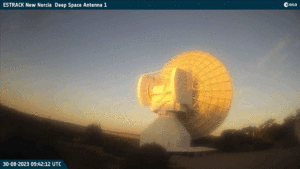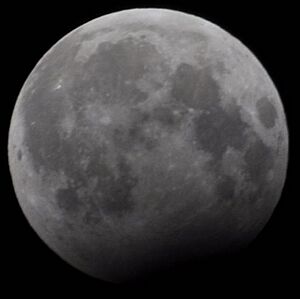Blue moon facts for kids
A blue moon can mean a few different things. Most often, it refers to when we see a second full moon in a single calendar month. It can also mean the third full moon in a season that has four full moons instead of the usual three. Sometimes, it even describes a moon that actually looks blue because of special conditions in the air.
The idea of a "blue moon" as a calendar event is quite new. It's not an ancient tradition, but something that started around 1937. An amateur astronomer named James Hugh Pruett helped make the idea of the second full moon in a month being "blue" popular in 1946. This idea did not come from Native American moon traditions, as some people think.
A calendrical blue moon happens because the time between two full moons (about 29.5 days) is a bit shorter than most calendar months. This means that every two or three years, we get an "extra" full moon in a year. This extra moon often falls as the second one in a month. These blue moons are predictable and happen about 7 times every 19 years. They don't have any special meaning in astronomy or history.
Contents
Why the Moon Can Look Blue
Sometimes, the moon (and even the sun) can truly appear blue. This happens under very specific weather conditions. For example, if large volcano eruptions or huge forest fires release tiny particles into the air, these particles can scatter light in a special way. If the particles are just the right size, they scatter red light more than blue light. This makes the moon look blue to us. This is a rare and unpredictable event, which is why we say "once in a blue moon" for something that hardly ever happens!
After the huge Krakatoa volcano erupted in 1883, people all over the world saw blue and green moons for months. One person in Central America even saw a crescent moon that looked like a "magnificent emerald-green" in 1884!
People also reported seeing blue moons after the El Chichón volcano erupted in Mexico in 1983. There were similar reports after Mount St. Helens erupted in 1980 and Mount Pinatubo in 1991.
Forest fires can also cause blue moons. In 1950 and 1951, large fires in Sweden and Canada made the moon look blue. On September 23, 1950, huge fires in Alberta, Canada, created a lot of smoke. This smoke contained tiny oily droplets, about 1 micrometre (a millionth of a meter) wide. These droplets were the perfect size to scatter red and yellow light. This made the sun look lavender or blue, and later, the moon looked blue too. The smoke traveled far, reaching Ontario, Canada, the eastern United States, and even Britain!
Even ice particles can have a similar effect. The explorer Robert Falcon Scott wrote in his diary on July 11, 1911, that the air was "thick with snow, and the moon a vague blue."
For the moon to look blue, there need to be many particles in the air that are slightly wider than the wavelength of red light (about 0.7 micrometers). Also, there shouldn't be many other sizes of particles. Most ash and dust clouds from fires or storms have a mix of particle sizes, with many smaller than 1 micrometer. These usually scatter blue light, which makes the moon look red. That's why red moons are much more common than blue ones!
What is a Calendrical Blue Moon?
The term "blue moon" as a calendar event first appeared in the 1937 Maine Farmers’ Almanac. This was a local magazine in the U.S. There's no proof that the term was used this way before 1937. It was probably invented by the magazine's editor, Henry Porter Trefethen.
The idea of a "blue moon" being the second full moon in a month became widely known in the U.S. in the mid-1980s. It then spread internationally in the late 1990s. This led some people to think the calendar meaning was very old, which wasn't true.
In 1999, a folklorist named Philip Hiscock looked into how the term spread. He found that the 1937 Maine Farmers' Almanac said the term was used "in olden times" for an extra full moon in a season. Later, in 1946, James Hugh Pruett wrote in Sky & Telescope magazine that a "blue moon" was the second full moon in a month. He said, "seven times in 19 years there were — and still are — 13 full moons in a year. This gives 11 months with one full moon each and one with two. This second in a month, so I interpret it, was called Blue Moon."
Pruett's definition became very popular. It was used in a radio show in 1980 and in a children's book in 1985. It even appeared as a question in the game Trivial Pursuit in 1986!
However, in 1999, astronomers researched the original almanac articles. They found that the Maine Farmers’ Almanac actually had a different rule. Their "blue moon" was the third full moon in a season that had four full moons. This is now sometimes called the "Maine rule" or "seasonal blue moon." Pruett's definition (second full moon in a month) was a misunderstanding of the original rule.
So, there are two main ways people define a calendrical blue moon:
- Pruett's rule: The second full moon in a calendar month. This is the most common meaning today.
- Maine rule: The third full moon in a season that has four full moons. This was the original meaning from the almanac.
When Do Blue Moons Happen?
A lunar cycle (the time from one full moon to the next) is about 29.5 days. A calendar year has about 365.24 days. This means there are about 12.37 lunar cycles in a year. Because of this, every two or three years, there's an "extra" full moon. This extra moon can be a "blue moon" by one of the definitions.
For example, a "Pruett" blue moon (second full moon in a month) happens about every 2 years, 8 months, and 18 days on average. Sometimes, two "Pruett" blue moons can even happen in a single year, like in 1915, 1961, 1999, 2018, and 2037. When this happens, the first one is in January, and the second is in March or April.
The next time New Year's Eve falls on a "Pruett" blue moon will be in 2028 in some parts of the world. At that time, there will also be a total lunar eclipse, which will be an amazing sight!
Images for kids
-
Blue moon of July 31, 2015, viewed from Port Coquitlam, Canada
See also
 In Spanish: Luna azul para niños
In Spanish: Luna azul para niños
- Black moon
- Blood moon – a reddish color a totally eclipsed Moon takes on to observers on Earth
- Wet moon
- Super moon









